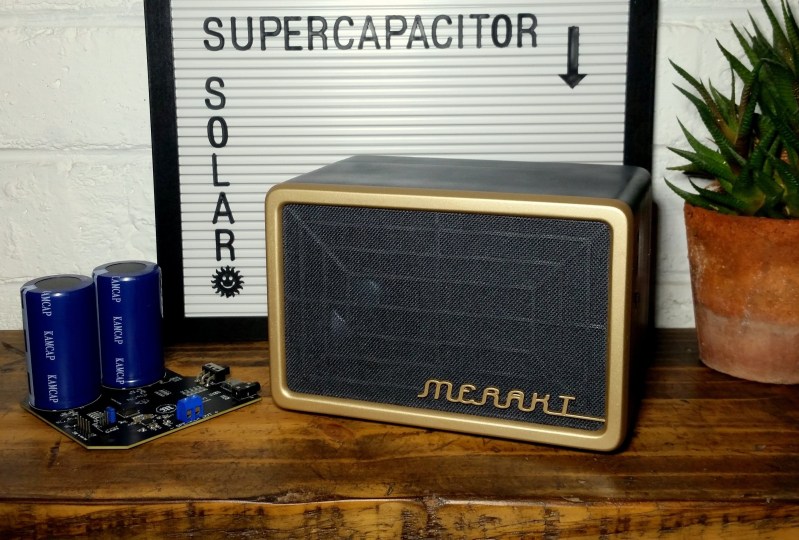Solar panels are a great way to generate clean electricity, but require some energy storage mechanism if you also want to use their power at night. This can be a bit tricky for large solar farms that feed into the grid, which require enormous battery banks or pumped storage systems to capture a reasonable amount of energy. It’s much easier for small, handheld solar gadgets, which work just fine with a small rechargeable battery or even a big capacitor. [Jamie Matthews], for instance, built a loudspeaker that runs on solar power but can also work in the dark thanks to two supercapacitors.
The speaker’s 3D-printed case has a 60 x 90 mm2 solar panel mounted at the front, which charges a pair of 400 Farad supercaps. Audio input is either through a classic 3.5 mm socket or through the analog audio feature of a USB-C socket. That same USB port can also be used to directly charge the supercaps when no sunlight is available, or to attach a Bluetooth audio receiver, which in that case will be powered by the speaker.

The speaker’s outer shell, the front bezel, and even the passive radiator are 3D-printed and spray-painted. The radiator is made of a center cap that is weighed down by a couple of M4 screws and suspended in a flexible membrane. [Jamie] used glue on all openings to ensure the box remains nearly airtight, which is required for the passive radiator to work properly. Speaker fabric is used to cover the front, including the solar panel – it’s apparently transparent enough to let a few watts of solar power through.
A salvaged three-inch Bose driver is the actual audio source. It’s driven by a TI TPA2013D1 chip, which is a 2.7 W class-D amplifier with an integrated boost converter. This enables the chip to keep a constant output power level across a wide supply voltage range – ideal for supercapacitor operation since supercaps don’t keep a constant voltage like lithium batteries do.
[Jamie] has used the speaker for more than nine months so far and has only had to charge it twice manually. It probably helps that he lives in sunny South Africa, but we’ve seen similar solar audio projects work just fine in places like Denmark. If you’re taking your boombox to the beach, a sunscreen reminder feature might also come in handy.



















Writing the user manual of an electronic equipment, I average two design issues. In the ritual chapters, the safety instructions recommends to avoid the heat sources.
As the speaker has a solar panel, it is charged on direct sunlight. Then the heat exposure cuts the lifetime aimed by the supercapacitors.
An exposed panel and a shilded electronics would be reasonnable, with wire and plug between the two. The removable batteries are coming back: instant refill, no charger wire, easy battery fix and EU regulations.
>easy battery fix and EU regulations.
I am rooting for this, but I will not believe it before I see it.
AFAIK “they” will ‘circumvent’ the rule but just making basically all smartphones/etc watertight to 1m depth or something.
Because the EU regulations have exceptions for such “special” devices and guess how those exceptions got in there.
(Pretty sure I read this or sth. along those lines on a credible source but never verified and it was some time ago.)
I much prefer plugging in a cable to charge a device rather than having to remove the battery and inserting it into a charger. Of course, the best is if both options are available.
I bought two devices recently (wireless keyboard/touchpad and a radio) and I was surprised to find a removable Nokia 3310 battery in each. Looks like that might be the new standard for China.
Beautiful build and nicely documented. I also like the vintage look.
I agree. Project website is worth looking at.
Nice project, but I have a question: There should be a mean to prevent a reverse flow current to the USB from the solar when they are producing more than the nominal 5V? I believe a diode or better a mosfet to minimize voltage drop can do the trick.
A Schottky diode usually has a voltage drop of around 0.2 volt… Is usually the best option
I think that the idea of placing solar panel under somecover and even in the room-facing direction is plain stupid. Now roast me.
Well it won’t get peak power this way that is certain. But it might actually be good for the panels lifespan – exposed it will get scratched, dirty or otherwise damaged in harder ways to deal with, and in direct sun could actually end up getting too hot for the mounting into the 3d print. So as long as this slightly shaded cell gets enough juice to run the project I don’t see it as an entirely bad idea, as the panel in use wouldn’t get any smaller I expect – only so many sizes of off the shelf solar module and you need more than the tiniest ones,you can buy. Plus nobody really wants to assemble raw cells into their own module.
I found some solar speakers for $15 on ali that are surprisingly good. I don’t think I’ve ever plugged them in. They’re fantastic for camping trips.
I wonder what would be the safety precautions and eventual issues to adapting this concept to Bluetooth headset.
The power requirements being smaller on headset drivers than on regular speaker I guess smaller capacitor could be used ?